
Health 'Insurance' at Sea: 1 2 3 4 5 6 7 8 9 10 11 12 13 <<First
Health 'Insurance' at Sea During the Golden Age of Piracy, Page 13
Long-Term Health Care - Pirates and Buccaneers
Pirates did not have the luxury of support from a concerned government or merchant company. As a result, they could not depend on being housed in an infirmary if they received crippling wounds. Nor did the temporary
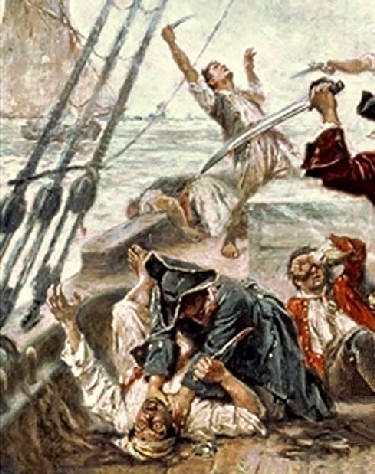
Artist: Jean Leon Gerome Ferris (1920)
nature of a pirate crew facilitate the building and maintenance of such a structure. The only likely way for a pirate to find his way into an almshouse would be if he returned to the service of the Navy or a merchant company and been wounded there.
Instead pirates built their support (and thus the encouragement to fight vigorously during battles) upon the concept of the smart money that the navy and some companies provided to their sailors. Nearly all pirates, particularly the regular men, had come from merchant and naval ships and would have been familiar with the pension structure and smart money one-time payment by the golden age of piracy.
The types of wounds to be awarded and the amounts given in recompense for such wounds were specified in the pirate articles. Articles were basically rules which guided a group of pirates. Each group of pirates had different sets of articles to govern them. (This is true at least for the groups whom we know of their articles. Since men were often required to sign these articles to join a pirate crew, this document was significantly damning evidence in court. If the pirates were losing a fight with a Navy vessel, they would often try to destroy the articles to hide this evidence.)
Such articles of agreement were not unique to the pirates. During the golden age of piracy, "almost every seaman would, at some point, have come into contact with some form of written agreement, or formalised rules governing behaviour."1 The navy provided instructions and regulations beginning in 1663 which were gathered and printed in 1731 as Regulations Relating to His Majesty's Service at Sea.2 In addition, merchant ships often had wage contracts which "stipulated the nature of the voyage to be undertaken, destination and ports of call, and, of course, the wages payable to each man."3
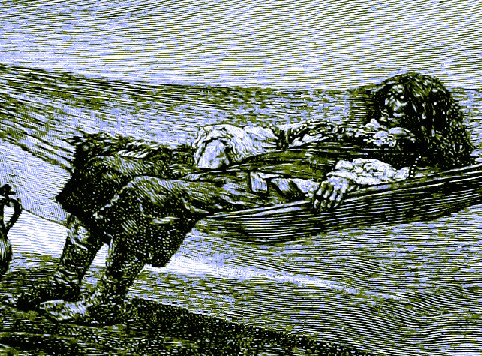
Artist: Howard Pyle - Henry Morgan, Resting (c. 1887)
Perhaps the group with the most significant impact on pirate articles with regard to smart money for wounding were those of privateer/buccaneer Henry Morgan. Although privateers functioned similarly to pirates in the taking and looting of vessels, they usually operated under government commissions so were technically an extension of the government which sanctioned them. (In fairness, it must be said that many of the buccaneers of the late 17th century exceeded their commission and so functioned at times as pirates.) Since privateers did not formally work for the government, however, they had to provide for themselves when wounded in taking towns and vessels.
Morgan's articles contain found the following statement (according the Exquemelin) with regard to paying men for wounds received in the course of their duties (Note that this has been reformatted from the original for clarity.):
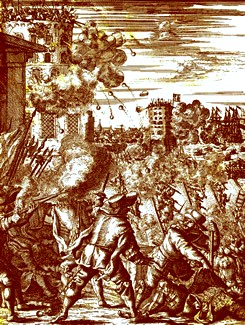
From The Buccaneers of America, p. 19 (1678)
Lastly, they agree what rate each one ought to have that is either wounded or maimed in his body, suffering the loss of any limb; as,
for the loss of a right arm, six hundred pieces of eight, or six slaves;
for the left arm, five hundred pieces of eight, or five slaves;
for a right leg, five hundred pieces of eight, or five slaves;
for the left leg, four hundred pieces of eight, or four slaves;
for an eye, one hundred pieces of eight, or one slave;
for a finger, the same as for an eye;
all which sums are taken out of the common stock4
It is notable how similar the wounds compensated is to the naval pensions listed previously, even if it is not quite as encompassing in its coverage. Still, this list is actually more comprehensive in coverage of types of wounds than any of the individual golden age of piracy articles. There is also provision in Morgan's articles for men killed in battle, whose "shares were given to their friends, to be kept entire for them, and to be delivered in due time to their nearest relations, or their apparent lawful heirs."5
With regard to golden age pirates, Dr. Ed Fox has provided the most extensive study of pirate articles that I have yet encountered. He shows eleven different pirate groups as having articles, or at least partial articles.6 Of these, six provide a description of recompense for long-term wounding. These include the articles of William Kidd (1696), Bartholomew Roberts (active 1719-22), Thomas Anstis (active 1721-3), John Philips (1723-24), George Lowther (active 1721-3) and Edward Low (active 1722-4).
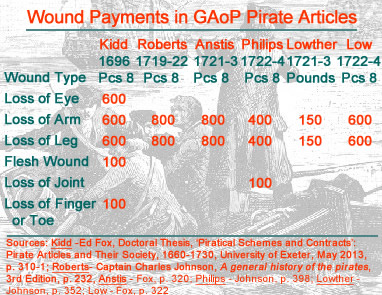
Image Artist: George Roux - Squire Trelawny Firing at Pirates (1885)
The payment in these documents are fairly straightforward and so are not quoted here in full, being rather shown in chart form at left. Bartholomew Roberts' articles do have a statement that this chart cannot adequately reflect because of its vagueness. They state that a man is to be paid "for lesser Hurts, proportionably", with 'lesser hurts' referring to wounds not requiring amputation.7
Dr. Fox notes that although the amounts paid out by George Lowther for wounds are in pounds instead of pieces of eight, the "smart money offered by pirate companies was remarkably consistent, both with other pirate companies and with privateer companies such as Kidd's."8 He goes on to explain that using a rough exchange rate of 4s 6d per dollar (referring to pieces of 8) makes Lowther's 150 pounds approximately equal to Low's 600 pieces of 8.
One additional benefit was offered by the articles of George Lowther and Edward Low. Both stated that the wounded man was allowed to remain on the ship "as long as he shall think fit."9 On this surface, this may seem like charity, but it is likely that a such a debilitated man remaining aboard would still have been given tasks of which he was capable, similar to the Navy giving cook's positions to pensioners as discussed previously. If nothing else, the wounded pirate could add to the number of men standing on the deck of the ship when they approached prey to help intimidate them.
Interestingly, of these six pirating groups who provide recompense for wounding, Roberts, Anstis and Philips all served with Howell Davis. Of the other three, Low was Lowther's Lieutenant until Lowther gave him a ship and they parted company in 1722. The similarity between the articles of these two related sets of pirates suggest their common source. Although Howell Davis' articles have not survived, it seems quite possible that they may have had a clause in them regarding the payment of those significantly wounded, given the similarity of the clauses found in Roberts', Anstis' and Philips' articles. The relationships between the different sets of articles containing wound compensation is shown below.
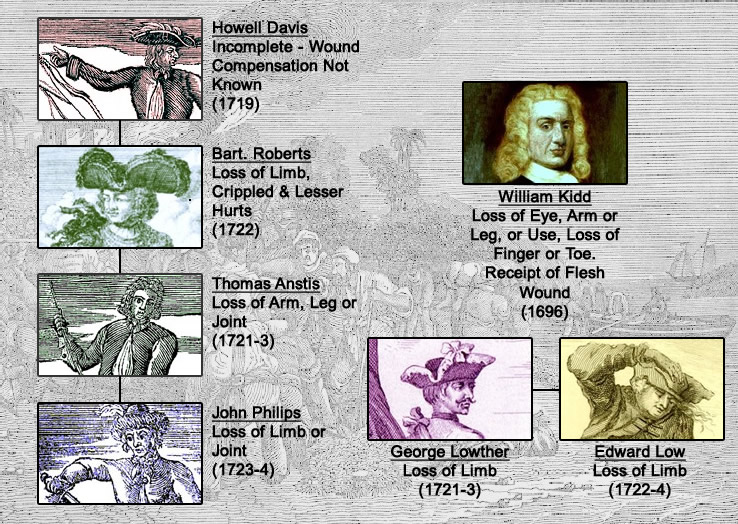
Image Artist: George Roux - Squire Trelawny Firing at Pirates (1885)
1 Ed Fox, Doctoral Thesis, 'Piratical Schemes and Contracts': Pirate Articles and Their Society, 1660-1730, University of Exeter, May 2013, p. 48; 2 N.A.M. Rodger, The Command of the Ocean, 2004, p. 320; , 3 Fox, p. 48; 4 Alexander Exquemelin, The History of the Buccaneers of America, 1856, p. 51-2; 5 Exquemelin, p. 78; 6 Fox, pp. 307-25; 7 Captain Charles Johnson, A general history of the pirates, 3rd Edition, p. 232; 8 Fox, p. 174; 9 Johnson, p. 352

